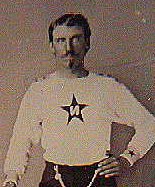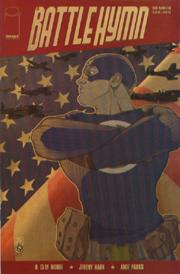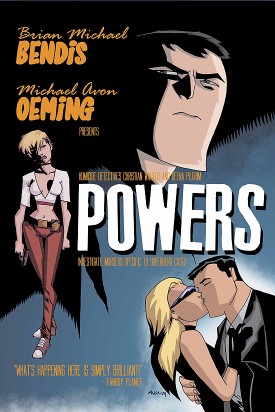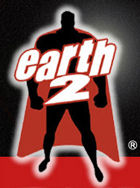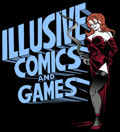|
|
|
|
Jason
Schachat wants to play a cleric in Paragon City.
|
Jason
Schachat's Weekly Breakdowns
March 3, 2005 You
know, there are times when I enjoy being addicted to City
of Heroes. This is one of them:
After a year of struggling to understand
why we should read the comic series that comes free with
subscription to the game, Cryptic and NCsoft give us a reason--
it’s being relaunched by Top Cow with Mark Waid at
the helm.
Oh, and it’ll still be free to game
subscribers.
The joy… oh, how it tingles…
Being
a sucker for modern Golden Age stories, it was hard to resist
Battle Hymn #1. That said, the
first issue gives us even less plot and less incentive to
buy the next one than the recent Seven Soldiers of Victory
premiere. In this case, we have a title that’s clearly
setting up the pieces in a chess game, but the creators
are still waiting to make the first move.
We open with a WWII era newsreel reporting
on the construction of a nuclear-powered artificial man.
Miracle of science, yadda yadda yadda. The scene quickly
shifts to a lonely beach where a woman of ill repute has
just been kicked out of her favorite bar. She strolls onto
the sand, takes a breath, and notices a merman stepping
out of the surf.
At Naval headquarters, agents review a top
secret film taken of the merman punching a hole through
the side of a destroyer. Clearly, he must represent an entire
race of undersea people; people the Navy wants to get to
know better. On the frontlines of the war, U.S. superhero
Proud American poses for pictures with the troops, then
gets a call to rush home. Celebrity speedster Johnny Zip
gets a visit from some G-men. A costumed British hero is
sent off to join the Americans.
|
|
|
No,
really, you haven't seen this before...
|
All in all, it looks like we have a new
team on our hands.
What
we don’t have is a clear cut conflict or villain.
For the most part, readers can guess that Nazis will be
involved somehow, but the writer is taking his sweet time
in telling us why any of this is happening. Luckily for
him, Jeremy Haun’s pencils capture the same weathered
photo-realism they do in the most recent Desperadoes
miniseries, while the added Golden Age elements lend far
more intrigue than you’d imagine.
One
could compare this to early Hellboy stories where weird
individuals were discovered and molded into a team, but
Battle Hymn is still firmly rooted in the retro
Golden Age setting. The characters represent a lovable hodgepodge
of Avengers and JSA wannabes, yet the real world aspects
of the story give the piece more texture than your average
Marvel/DC flashback story.
Still,
this issue does nothing more than introduce us to some new
“heroes." Aside from knowing that America and
Britain are assembling them, this story is a complete mystery.
While Haun’s art makes it a compelling one, I’m
going to wait another month before handing out a recommendation.
Hunter-Killer
#1 teaches us two very important lessons.
A) How damaging a zero issue can be when trying to establish
continuity. B) How an A-list writer’s script can be
twisted and tangled into a mess by an A-list penciller.
The story opens with U.S. agents prying
into the last thoughts of a severed head they recovered
from a fallen assassin. Sifting through the psychic residue,
they weed out the address where “The Catalog”,
a mysterious thingie that would allow the government to
track down rogue “Ultra-Sapiens”, is located.
At the location in question, a teenage boy
and his parents argue about his desire to get a job and
see the rest of the world outside their remote homestead.
He then grabs some iodine pills out of the cupboard and
can’t figure out why he felt the need to take one,
but his parents quickly recognize what’s wrong: the
boy’s supernatural instincts are readying him for
radiation poisoning. Something big is going down.
Mark
Waid comes up with a few smart ideas in this story, but
it’s pretty confusing until the end. Marc Silvestri’s
art has never been the clearest, but the way he floods pages
with messy linework and ugly little panels makes Hunter-Killer
a strain on the eyes. More to the point, some sights are
just ridiculous. The teenage boy looks like he’s 27,
every character has a perfect physique, and the remote homestead
looks SO remote, I doubt it would have an address, much
less one involving a “Lane”.
It might have been better if Waid had worked
with another artist, but this book is clearly the child
of both its parents. Unfortunately, those parents don’t
have much chemistry (certainly nothing approaching Waid’s
connection with Barry Kitson or Mark Wieringo). The story
feels choppy and disorganized, the main characters don’t
demonstrate any personality, and the more interesting elements
of the book are blown to kingdom come before the last page.
This title may come together, given time.
It may start making sense, find a direction, and move us
into bold new territory. Someday. It sure as hell ain’t
happening this month.
|
|
|
Notice
where the cover quote comes from?
|
Just
when the title was starting to get sleepy, Powers
#9 pulls the usual Bendis switcheroo. Admittedly,
this outing isn’t as cleverly constructed as twists
of the past, but it’ll still leave you feeling gut-punched
and slap-happy.
Having discovered supervillain The Joke
bumped off in his lair last time around, Detectives Walker
and Pilgrim delve deeper into their investigation of the
Blackguard murders. This time, however, they face the new
threat of a nosey reporter who knows way more than the police
would like. Oh, and she may have had a thing with Walker
in the past.
Back on the case, Walker and Pilgrim verify
that The Joke had his tongue ripped from his throat, indicating
someone was tired of him mouthing off. But, with The Joke’s
innate powers, that means the killer had to be one helluva
beefcake. And, as if that weren’t enough of a concern,
Pilgrim’s own super strength seems ready to get her
into a whole new world of trouble.
Of course, none of that’s surprising,
but I’m not going to reveal the surprise ending. It’s
a surprise. Deal with it.
The
twist satisfies, but it was needed, since the plot started
to simmer down. Powers still has yet to think up
a twist as powerful as the Olympia “tell all”
issue from the last volume, but this one still catches you
with your pants down. Next issue should thread Callista
and the other rogue powers back into the story, providing
more excitement and bloodshed than this issue. For now,
the party’s just getting started. Recommended.
The
X-franchise may finally have kissed Chuck Austen goodbye,
but Peter Milligan doesn’t quite prove himself the
series’ savior on X-Men #167.
We’re still knee-deep in melodrama, members of other
X-teams are flitting in and out of the narrative without
any explanation, and, even though we haven’t seen
this story before, we’ve seen this story before.
On the streets of Los Angeles, a young mutant
slinks down the sidewalk, remembering how his wealthy human
employers wouldn’t let him into their shelter when
the mutant riots began. It was probably a good idea, he
thinks, since the madness has also taken hold of him, pushing
him to lead an army of crazed mutants on their rampage.
Down in Antarctica, Havok and his team scour
a mutant colony turned abattoir, hoping for a clue to the
cause of this mutant madness. Each member starts to react
differently to a presence deep inside the facility, remembering
horrific ordeals, shooting their mouths off, and giving
in to paranoia. Then they find the fungoid dinosaur thing
responsible for all the chaos and think it quite a good
idea to take the monstrosity back home with them.
Yup, it’s the same old story.
Now,
while Emma Frost’s sudden appearance last issue was
confusing, Wolverine’s makes even less sense. He was
waiting in the spare X-jet the whole time? Does that mean
Emma WASN’T a psi-projection when she suddenly appeared
last month? If all this is true, why didn’t they send
a heavy hitter like Wolvie in when those stir-crazy mutants
were trying to kill them?
Rogue and Gambit continue to dance around
their intimacy issues, though now with even more angst since
Gambit’s blindness was cured before he could milk
all the angst out of it. Tensions are also mounting between
Polaris and Havok, though Lorna’s madness makes for
a better excuse (Havok’s constant redesigning of his
costume doesn’t help his own case much, however).
But what it all comes down to is this team
is still ineffective, uninteresting, and unimportant. Nothing
they do will amount to much, and no changes will be permanent.
While Milligan may deserve some blame for watering down
his bibilical tale with the standard soap opera elements,
this is, again, something where the whole Marvel staff needs
a good slap on the wrist.
X-Men
has only ever been good when the creators have been allowed
a certain measure of freedom. Now that the team has become
the whiney, underpowered joke of the X-franchise, the characters
need to grow. Rogue needs to be more than “I can’t
touch people”, Havok needs to be more than “I’m
not my brother”, Iceman needs to be more than “I
didn’t mean to be so insulting”, and, for God’s
sake, stop taking Gambit back to square one every six months.
With
a team this lackluster and so many replacement mutants floating
around the mansion, it doesn’t even matter if one
of these schmoes dies. Heck, just look how Austen tossed
Juggernaut and Nocturne into a black hole without anyone
batting an eyelash (and Juggs may have been the most well
developed character on the team). Until Marvel can give
us a team we can care about, there simply isn’t any
reason to read X-Men.
|
